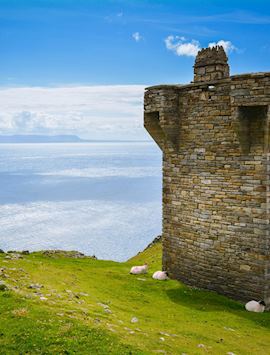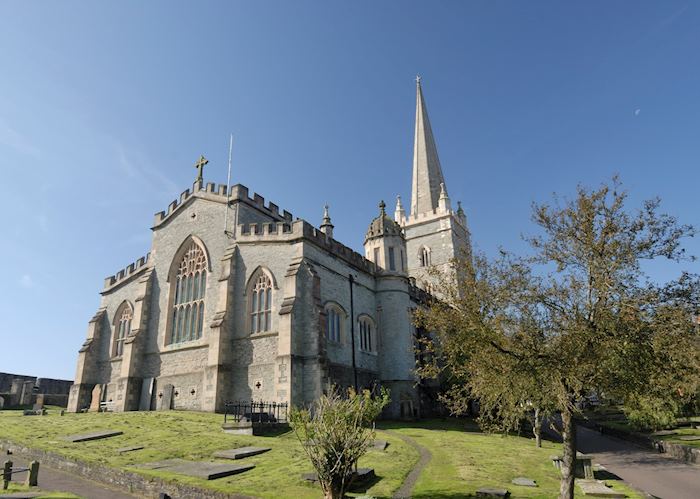Jump to:
Enclosed within some of the best-preserved city walls in Europe, Northern Ireland’s second-largest city retains its medieval street plan and celebrates its long but complex history. The city is entirely forward-thinking, though, with urban regeneration projects reviving the waterside along the River Foyle, a thriving arts and music scene, and a host of popular festivals throughout the year.
Although some remnants of the Troubles remain, such as the Bogside murals, today’s city makes a rewarding base for exploring the Antrim Coast and local attractions such as the Ulster Folk Museum and the Seamus Heaney HomePlace.
Your best introduction to the city is a walk along the 17th-century city walls, which remain almost intact. Nicknamed the ‘Maiden City’ because its walls were never breached, Derry is the only complete walled city in Ireland. After a long history of fighting between Irish chieftains and English invaders, the British fortified the city in 1613, renamed it Londonderry and began the plantation of English and Scottish settlers in the surrounding areas.
The Siege of Derry, between 1688 and 1689, was part of the Williamite War between Protestant William of Orange and Catholic King James. The Williamites eventually won and the city’s Catholics were forced to emigrate, many to America, in large numbers. You can visit a small museum that covers the history of the siege in Saint Columb’s Cathedral to understand the events in more detail.
Discrimination against Catholics continued for centuries. After the partition of Ireland in 1921, they were often denied their civil rights, although they formed the majority in the city. Early clashes here are generally seen as the stimulus for the modern Troubles.
Violent clashes at civil-rights marches and the events of Bloody Sunday in 1972 remain in vivid memory. They’re commemorated in the political murals on the Catholic Bogside, which you can see from the northern part of the city walls.
The People’s Gallery consists of 12 murals depicting events from the Troubles, and hopes for a peaceful future. In Protestant areas, political allegiances are reflected in red, white and blue stripes painted along the roadside.
Although the city has long been peaceful, a community divide still exists and most Catholics live west of the Foyle and the Protestants to the east. The pedestrian Peace Bridge opened in 2011 to join the two sides of the river, its structural arms leaning toward each other in a symbolic gesture of peace. It’s a pleasant walkway or cycle way that offers you views over the river. It also connects the Guildhall with regenerated Ebrington Square, a former army parade ground that’s now a public square.
Tensions do still simmer in the background, and even the name of the city has long been a bone of contention. Pro-British Unionists use the name Londonderry, where Nationalists use Derry. In 2015, the city council voted to change the city’s official name to Derry, though staunch Unionists objected to the move and a later High Court ruling decreed that the official name of the city could only be changed by the Monarch or by British legislation.
The Antrim Coast stretches to the east beyond the city, with Donegal’s wild Inishowen Peninsula to the west. You can reach either easily from Derry, making it a good base for exploring the clifftop Mussenden Temple, the dovecotes and gardens of Downhill Demesne, or the near-deserted beaches and blustery headlands of Donegal.
South of Derry, in Omagh, the Ulster American Folk Park is a huge outdoor museum that traces the journey of Irish emigrants to America during the Great Famine. Between 1845 and 1849, almost two million Ulster people left their homes in search of a new life across the Atlantic. You can visit thatched cottages and talk to costumed guides, and see the conditions people lived in at home. The museum also follows their journey on board the coffin ships and explores what life was like once they arrived in the New World.
Head southeast of Derry toward Magherafelt and you enter the homeland of Nobel-Prize-winning poet Seamus Heaney.
The Seamus Heaney HomePlace, an interactive museum in his hometown of Bellaghy, showcases his work in the context of the local landscape, taking references from his poems that describe the surrounding farms, villages and people.
Best time to visit Derry/Londonderry
Derry is great to visit at any time of year, and it doesn’t get as busy as other Irish cities. Summer is a good time to visit, and it’s generally warm and dry with long days between May and September. We love April and May and September and October as times to visit, when new flowers or turning leaves bring the landscape to life. Winter is quieter and some attractions close, but on a fine day it can be magical.
who's been there

Start planning your tailor-made trip to Derry/Londonderry by contacting one of our Ireland specialists
-
617-223-4521617-223-4757
- Make an inquiry
Suggested itinerary featuring Derry/Londonderry
This sample itinerary will give you an idea of what is possible when you travel in Derry/Londonderry, and showcases routes we know work particularly well. Treat this as inspiration, because your trip will be created uniquely by one of our specialists.
Places near Derry/Londonderry
- Northern Ireland 27 miles away
- Giant’s Causeway 36 miles away
- County Donegal 40 miles away
- Enniskillen 47 miles away
- Belfast 62 miles away
- Sligo 69 miles away
- Newgrange and the Boyne Valley 97 miles away
- Dublin 122 miles away
- Galway 139 miles away
- Connemara 146 miles away
- The Burren 154 miles away
- Inis Mór 162 miles away
- Kilkenny 163 miles away
- Limerick 170 miles away
- County Wexford 188 miles away
- Waterford 190 miles away
- Cork 220 miles away
- Cobh 222 miles away
- Killarney 223 miles away
- Dingle Peninsula 232 miles away
- Kinsale 234 miles away
- Kenmare 236 miles away
Photos of Derry/Londonderry
Accommodation choices for Derry/Londonderry
We've selected a range of accommodation options for when you visit Derry/Londonderry. Our choices usually come recommended for their character, facilities and service or location. Our specialists always aim to suggest properties that match your preferences.
-
![Beech Hill Country House]()
Beech Hill Country House
Derry/Londonderry -
![Bishop's Gate hotel]()
Bishop's Gate Hotel
Derry/Londonderry
Ideas for experiencing Derry/Londonderry
Our specialists seek out authentic ways to get to know the places that could feature in your trip. These activities reflect some of the experiences they've most enjoyed while visiting Derry/Londonderry, and which use the best local guides.
-
Derry/Londonderry city tour ![Old cannons in Derry/Londonderry]()
Derry/Londonderry city tour
Derry/Londonderry city tour
Discover the history, culture and landmarks of Derry/Londonderry as you walk the city streets and fortified walls with a private guide. You’ll hear about everything from the Williamite War to famine history, emigration, civil rights, and the Troubles.
View details








